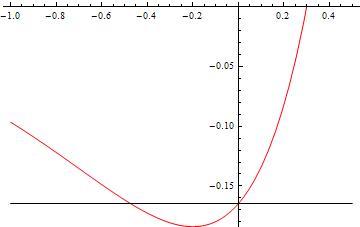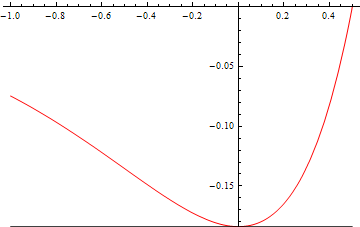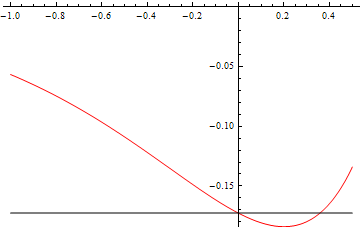Phy5645/doubledelta: Difference between revisions
(Double Delta potential ground state problem) |
No edit summary |
||
| (5 intermediate revisions by the same user not shown) | |||
| Line 1: | Line 1: | ||
The potential that we are considering is even, and thus the wave functions must have definite parity. We divide the one-dimensional space into three regions; region I is <math>x<-a\!</math>, region II is <math>-a<x<a\!</math>, and region III is <math>x>a.\!</math> Since the wave function must have definite parity, there are two possibilities for the form of the wave function. Let us first consider an even wave function, which will have the form, | |||
<math>\psi_I(x)=Ae^{kx},\!</math> | |||
<math>\psi_{II}(x)=B\cosh{kx},\!</math> | |||
<math>\psi_{III}(x)=Ae^{-kx},\!</math> | |||
where <math>k=\frac{\sqrt{-2mE}}{\hbar}.</math> We now apply the boundary conditions at <math>x=\pm a.\!</math> The continuity condition at <math>x=-a\!</math> gives us | |||
<math>Ae^{-ka}=B\cosh{ka}.\!</math> | |||
The derivative, on the other hand, is discontinuous; the condition in it is | |||
<math>\psi'_{II}(-a)-\psi'_I(-a)=-\frac{2mg}{\hbar^2}\psi(-a).</math> | |||
This condition yields | |||
<math>-kB\sinh{ka}-kAe^{-ka}=-\frac{2mg}{\hbar^2}B\cosh{ka}.</math> | |||
The | The corresponding conditions at <math>x=a\!</math> yield the same equations. We can eliminate <math>A\!</math> and <math>B\!</math> from the above equations, obtaining the following equation for <math>k\!</math>: | ||
the right hand side | <math>(\kappa-\gamma)e^{2(\kappa-\gamma)}=\gamma e^{-2\gamma},\!</math> | ||
where <math>\kappa=ka\!</math> and <math>\gamma=\frac{ma}{\hbar^2}g.</math> In order for a bound state to exist, there must be a solution to the above equation for which <math>\kappa>0.\!</math> We note that the right-hand side is always positive, while the left-hand side is only positive for <math>\kappa>\gamma\!</math> and increases indefinitely as we increase <math>\kappa.\!</math> Therefore, there will always be a physically relevant solution of the above equation, and therefore there is always a bound state of even parity. | |||
Now let us consider an odd wave function. Such a wave function will have the form, | |||
<math>\psi_I(x)=Ae^{kx},\!</math> | |||
<math>\psi_{II}(x)=B\sinh{kx},\!</math> | |||
<math>\psi_{III}(x)=-Ae^{-kx}.\!</math> | |||
The same procedure as before yields the following equation: | |||
<math>(\kappa-\gamma)e^{2(\kappa-\gamma)}=-\gamma e^{-2\gamma}.\!</math> | |||
Unlike the even parity case, however, this equation may not have a solution for which <math>\kappa>0.\!</math> First, let us note that <math>\kappa=0\!</math> is always a solution to the above equation. If we find the minimum of the left-hand side, we find that it occurs at <math>\kappa=\gamma-\tfrac{1}{2},</math> at which point the left-hand side becomes <math>-\frac{1}{2e}.</math> This is also the smallest value that the right-hand side can possibly take, which it acquires for <math>\gamma=\tfrac{1}{2}.</math> If <math>\gamma\leq\tfrac{1}{2},</math> then this implies that no solution exists for which <math>\kappa>0,\!</math> since the left-hand side only becomes less than the right-hand side for negative values of <math>\kappa.\!</math> On the other hand, if <math>\gamma>\tfrac{1}{2},</math> then we will find a solution for which <math>\kappa>0.\!</math> Thus, a second bound state of odd parity will also exist provided that <math>\frac{2ma}{\hbar^2}g>1;</math> i.e., if the separation of the delta function wells is sufficiently large, or if their strength is sufficiently high. | |||
To illustrate this graphically, let us plot the left-hand side as a function of <math>\kappa\!</math> versus the right-hand side for several values of <math>\gamma\!</math>. In all of the below plots, the red curve is the left-hand side, while the black line is the right-hand side. Below is a plot for <math>\gamma=0.3:\!</math> | |||
[[File:DoubleDelta_gamma_too_small.png]] | |||
Here, we see that, in addition to <math>\kappa=0,\!</math> the only other solution is for a <math>\kappa<0,\!</math> which is unphysical. | |||
Let us now increase <math>\gamma\!</math> to <math>0.5:\!</math> | |||
[[File:DoubleDelta_gamma_critical.png]] | |||
The negative <math>\kappa\!</math> solution has disappeared, and we are left with the (still unphysical) trivial solution, <math>\kappa=0.\!</math> | |||
Now let us look at the plot for <math>\gamma=0.7:\!</math> | |||
[[File:DoubleDelta_gamma_large_enough.png]] | |||
We see that there is now a solution for which <math>\kappa>0.\!</math> | |||
Back to [[The Dirac Delta Function Potential#Problem|The Dirac Delta Function Potential]] | |||
Latest revision as of 13:30, 18 January 2014
The potential that we are considering is even, and thus the wave functions must have definite parity. We divide the one-dimensional space into three regions; region I is Failed to parse (SVG (MathML can be enabled via browser plugin): Invalid response ("Math extension cannot connect to Restbase.") from server "https://wikimedia.org/api/rest_v1/":): {\displaystyle x<-a\!} , region II is Failed to parse (SVG (MathML can be enabled via browser plugin): Invalid response ("Math extension cannot connect to Restbase.") from server "https://wikimedia.org/api/rest_v1/":): {\displaystyle -a<x<a\!} , and region III is Failed to parse (SVG (MathML can be enabled via browser plugin): Invalid response ("Math extension cannot connect to Restbase.") from server "https://wikimedia.org/api/rest_v1/":): {\displaystyle x>a.\!} Since the wave function must have definite parity, there are two possibilities for the form of the wave function. Let us first consider an even wave function, which will have the form,
Failed to parse (SVG (MathML can be enabled via browser plugin): Invalid response ("Math extension cannot connect to Restbase.") from server "https://wikimedia.org/api/rest_v1/":): {\displaystyle \psi_I(x)=Ae^{kx},\!}
Failed to parse (SVG (MathML can be enabled via browser plugin): Invalid response ("Math extension cannot connect to Restbase.") from server "https://wikimedia.org/api/rest_v1/":): {\displaystyle \psi_{II}(x)=B\cosh{kx},\!}
Failed to parse (SVG (MathML can be enabled via browser plugin): Invalid response ("Math extension cannot connect to Restbase.") from server "https://wikimedia.org/api/rest_v1/":): {\displaystyle \psi_{III}(x)=Ae^{-kx},\!}
where Failed to parse (SVG (MathML can be enabled via browser plugin): Invalid response ("Math extension cannot connect to Restbase.") from server "https://wikimedia.org/api/rest_v1/":): {\displaystyle k=\frac{\sqrt{-2mE}}{\hbar}.} We now apply the boundary conditions at Failed to parse (SVG (MathML can be enabled via browser plugin): Invalid response ("Math extension cannot connect to Restbase.") from server "https://wikimedia.org/api/rest_v1/":): {\displaystyle x=\pm a.\!} The continuity condition at Failed to parse (SVG (MathML can be enabled via browser plugin): Invalid response ("Math extension cannot connect to Restbase.") from server "https://wikimedia.org/api/rest_v1/":): {\displaystyle x=-a\!} gives us
Failed to parse (SVG (MathML can be enabled via browser plugin): Invalid response ("Math extension cannot connect to Restbase.") from server "https://wikimedia.org/api/rest_v1/":): {\displaystyle Ae^{-ka}=B\cosh{ka}.\!}
The derivative, on the other hand, is discontinuous; the condition in it is
Failed to parse (SVG (MathML can be enabled via browser plugin): Invalid response ("Math extension cannot connect to Restbase.") from server "https://wikimedia.org/api/rest_v1/":): {\displaystyle \psi'_{II}(-a)-\psi'_I(-a)=-\frac{2mg}{\hbar^2}\psi(-a).}
This condition yields
Failed to parse (SVG (MathML can be enabled via browser plugin): Invalid response ("Math extension cannot connect to Restbase.") from server "https://wikimedia.org/api/rest_v1/":): {\displaystyle -kB\sinh{ka}-kAe^{-ka}=-\frac{2mg}{\hbar^2}B\cosh{ka}.}
The corresponding conditions at Failed to parse (SVG (MathML can be enabled via browser plugin): Invalid response ("Math extension cannot connect to Restbase.") from server "https://wikimedia.org/api/rest_v1/":): {\displaystyle x=a\!} yield the same equations. We can eliminate Failed to parse (SVG (MathML can be enabled via browser plugin): Invalid response ("Math extension cannot connect to Restbase.") from server "https://wikimedia.org/api/rest_v1/":): {\displaystyle A\!} and Failed to parse (SVG (MathML can be enabled via browser plugin): Invalid response ("Math extension cannot connect to Restbase.") from server "https://wikimedia.org/api/rest_v1/":): {\displaystyle B\!} from the above equations, obtaining the following equation for Failed to parse (SVG (MathML can be enabled via browser plugin): Invalid response ("Math extension cannot connect to Restbase.") from server "https://wikimedia.org/api/rest_v1/":): {\displaystyle k\!} :
Failed to parse (SVG (MathML can be enabled via browser plugin): Invalid response ("Math extension cannot connect to Restbase.") from server "https://wikimedia.org/api/rest_v1/":): {\displaystyle (\kappa-\gamma)e^{2(\kappa-\gamma)}=\gamma e^{-2\gamma},\!}
where Failed to parse (SVG (MathML can be enabled via browser plugin): Invalid response ("Math extension cannot connect to Restbase.") from server "https://wikimedia.org/api/rest_v1/":): {\displaystyle \kappa=ka\!} and Failed to parse (SVG (MathML can be enabled via browser plugin): Invalid response ("Math extension cannot connect to Restbase.") from server "https://wikimedia.org/api/rest_v1/":): {\displaystyle \gamma=\frac{ma}{\hbar^2}g.} In order for a bound state to exist, there must be a solution to the above equation for which Failed to parse (SVG (MathML can be enabled via browser plugin): Invalid response ("Math extension cannot connect to Restbase.") from server "https://wikimedia.org/api/rest_v1/":): {\displaystyle \kappa>0.\!} We note that the right-hand side is always positive, while the left-hand side is only positive for Failed to parse (SVG (MathML can be enabled via browser plugin): Invalid response ("Math extension cannot connect to Restbase.") from server "https://wikimedia.org/api/rest_v1/":): {\displaystyle \kappa>\gamma\!} and increases indefinitely as we increase Failed to parse (SVG (MathML can be enabled via browser plugin): Invalid response ("Math extension cannot connect to Restbase.") from server "https://wikimedia.org/api/rest_v1/":): {\displaystyle \kappa.\!} Therefore, there will always be a physically relevant solution of the above equation, and therefore there is always a bound state of even parity.
Now let us consider an odd wave function. Such a wave function will have the form,
Failed to parse (SVG (MathML can be enabled via browser plugin): Invalid response ("Math extension cannot connect to Restbase.") from server "https://wikimedia.org/api/rest_v1/":): {\displaystyle \psi_I(x)=Ae^{kx},\!}
Failed to parse (SVG (MathML can be enabled via browser plugin): Invalid response ("Math extension cannot connect to Restbase.") from server "https://wikimedia.org/api/rest_v1/":): {\displaystyle \psi_{II}(x)=B\sinh{kx},\!}
Failed to parse (SVG (MathML can be enabled via browser plugin): Invalid response ("Math extension cannot connect to Restbase.") from server "https://wikimedia.org/api/rest_v1/":): {\displaystyle \psi_{III}(x)=-Ae^{-kx}.\!}
The same procedure as before yields the following equation:
Failed to parse (SVG (MathML can be enabled via browser plugin): Invalid response ("Math extension cannot connect to Restbase.") from server "https://wikimedia.org/api/rest_v1/":): {\displaystyle (\kappa-\gamma)e^{2(\kappa-\gamma)}=-\gamma e^{-2\gamma}.\!}
Unlike the even parity case, however, this equation may not have a solution for which Failed to parse (SVG (MathML can be enabled via browser plugin): Invalid response ("Math extension cannot connect to Restbase.") from server "https://wikimedia.org/api/rest_v1/":): {\displaystyle \kappa>0.\!} First, let us note that Failed to parse (SVG (MathML can be enabled via browser plugin): Invalid response ("Math extension cannot connect to Restbase.") from server "https://wikimedia.org/api/rest_v1/":): {\displaystyle \kappa=0\!} is always a solution to the above equation. If we find the minimum of the left-hand side, we find that it occurs at Failed to parse (SVG (MathML can be enabled via browser plugin): Invalid response ("Math extension cannot connect to Restbase.") from server "https://wikimedia.org/api/rest_v1/":): {\displaystyle \kappa=\gamma-\tfrac{1}{2},} at which point the left-hand side becomes Failed to parse (SVG (MathML can be enabled via browser plugin): Invalid response ("Math extension cannot connect to Restbase.") from server "https://wikimedia.org/api/rest_v1/":): {\displaystyle -\frac{1}{2e}.} This is also the smallest value that the right-hand side can possibly take, which it acquires for Failed to parse (SVG (MathML can be enabled via browser plugin): Invalid response ("Math extension cannot connect to Restbase.") from server "https://wikimedia.org/api/rest_v1/":): {\displaystyle \gamma=\tfrac{1}{2}.} If Failed to parse (SVG (MathML can be enabled via browser plugin): Invalid response ("Math extension cannot connect to Restbase.") from server "https://wikimedia.org/api/rest_v1/":): {\displaystyle \gamma\leq\tfrac{1}{2},} then this implies that no solution exists for which Failed to parse (SVG (MathML can be enabled via browser plugin): Invalid response ("Math extension cannot connect to Restbase.") from server "https://wikimedia.org/api/rest_v1/":): {\displaystyle \kappa>0,\!} since the left-hand side only becomes less than the right-hand side for negative values of Failed to parse (SVG (MathML can be enabled via browser plugin): Invalid response ("Math extension cannot connect to Restbase.") from server "https://wikimedia.org/api/rest_v1/":): {\displaystyle \kappa.\!} On the other hand, if Failed to parse (SVG (MathML can be enabled via browser plugin): Invalid response ("Math extension cannot connect to Restbase.") from server "https://wikimedia.org/api/rest_v1/":): {\displaystyle \gamma>\tfrac{1}{2},} then we will find a solution for which Failed to parse (SVG (MathML can be enabled via browser plugin): Invalid response ("Math extension cannot connect to Restbase.") from server "https://wikimedia.org/api/rest_v1/":): {\displaystyle \kappa>0.\!} Thus, a second bound state of odd parity will also exist provided that Failed to parse (SVG (MathML can be enabled via browser plugin): Invalid response ("Math extension cannot connect to Restbase.") from server "https://wikimedia.org/api/rest_v1/":): {\displaystyle \frac{2ma}{\hbar^2}g>1;} i.e., if the separation of the delta function wells is sufficiently large, or if their strength is sufficiently high.
To illustrate this graphically, let us plot the left-hand side as a function of Failed to parse (SVG (MathML can be enabled via browser plugin): Invalid response ("Math extension cannot connect to Restbase.") from server "https://wikimedia.org/api/rest_v1/":): {\displaystyle \kappa\!} versus the right-hand side for several values of Failed to parse (SVG (MathML can be enabled via browser plugin): Invalid response ("Math extension cannot connect to Restbase.") from server "https://wikimedia.org/api/rest_v1/":): {\displaystyle \gamma\!} . In all of the below plots, the red curve is the left-hand side, while the black line is the right-hand side. Below is a plot for Failed to parse (SVG (MathML can be enabled via browser plugin): Invalid response ("Math extension cannot connect to Restbase.") from server "https://wikimedia.org/api/rest_v1/":): {\displaystyle \gamma=0.3:\!}
Here, we see that, in addition to Failed to parse (SVG (MathML can be enabled via browser plugin): Invalid response ("Math extension cannot connect to Restbase.") from server "https://wikimedia.org/api/rest_v1/":): {\displaystyle \kappa=0,\!} the only other solution is for a Failed to parse (SVG (MathML can be enabled via browser plugin): Invalid response ("Math extension cannot connect to Restbase.") from server "https://wikimedia.org/api/rest_v1/":): {\displaystyle \kappa<0,\!} which is unphysical.
Let us now increase Failed to parse (SVG (MathML can be enabled via browser plugin): Invalid response ("Math extension cannot connect to Restbase.") from server "https://wikimedia.org/api/rest_v1/":): {\displaystyle \gamma\!} to Failed to parse (SVG (MathML can be enabled via browser plugin): Invalid response ("Math extension cannot connect to Restbase.") from server "https://wikimedia.org/api/rest_v1/":): {\displaystyle 0.5:\!}
The negative Failed to parse (SVG (MathML can be enabled via browser plugin): Invalid response ("Math extension cannot connect to Restbase.") from server "https://wikimedia.org/api/rest_v1/":): {\displaystyle \kappa\!} solution has disappeared, and we are left with the (still unphysical) trivial solution, Failed to parse (SVG (MathML can be enabled via browser plugin): Invalid response ("Math extension cannot connect to Restbase.") from server "https://wikimedia.org/api/rest_v1/":): {\displaystyle \kappa=0.\!}
Now let us look at the plot for Failed to parse (SVG (MathML can be enabled via browser plugin): Invalid response ("Math extension cannot connect to Restbase.") from server "https://wikimedia.org/api/rest_v1/":): {\displaystyle \gamma=0.7:\!}
We see that there is now a solution for which Failed to parse (SVG (MathML can be enabled via browser plugin): Invalid response ("Math extension cannot connect to Restbase.") from server "https://wikimedia.org/api/rest_v1/":): {\displaystyle \kappa>0.\!}


